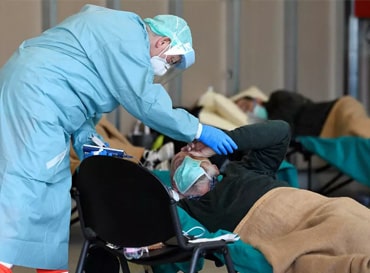
The Million Dollar Question. Which COVID Test is Best?
One of the COVID tests currently used by us is the Becton Dickinson BD Veritor system for the rapid detection of SARS-COV-2 virus. This is an FDA-authorized antigen test that detects current infection with the virus. The sample for this test is obtained via a nasal swab, and results are available in 15 minutes.
The data provided to the FDA by Becton Dickinson demonstrated an overall percent agreement (OPA) of 98% when compared to a three-hour polymerase chain reaction (PCR) which is currently considered the benchmark for evaluating new tests. The definition of overall percent agreement (OPA) is True Positives + True Negatives / Total Samples. In this same data set, the positive percent agreement (PPA) of the BD Veritor was reported as 84% and its negative percent agreement (NPA) as 100%. For the most part, people want to know if this means the BD Veritor is a “good test.” To address this question, it is helpful to understand the methods used for detecting viruses and other pathogens and how these methods have evolved over time.
Over the years, the strategies for detecting infections have progressed immensely. Just two decades ago, the medical community primarily relied on cultures to determine whether or not infections were present. Cultures were considered the gold standard but could be finicky and often took days. With this method, samples were placed in petri dishes and needed time to grow before one could ascertain whether or not a particular bacteria or virus was present. Some pathogens grew quickly and others more slowly, so the amount of time it took to receive results actually depended on the organism itself. For some infections, there was a high rate of false negatives due to sampling and processing difficulties. It was accepted that many cultures did not have an accuracy (or sensitivity) of greater than 75%.
Then, Polymerase Chain Reaction (PCR) technology was created, and throughout the 1990’s and early 2000’s, this method was customized and adapted to detect a wide variety of pathogens, including viruses. This was a true technological breakthrough for diagnosing infections, as clinicians could detect the presence of a pathogen by identifying a specific fragment of its DNA as opposed to requiring it to grow in culture. PCR was soon found to have superior sensitivity to cultures and became universally utilized by clinicians. These tests are also known as molecular or nucleic acid tests.
Paralleling the growth of PCR technology was yet a third method used to diagnose activeinfections, and this was the antigen test. These tests detect the presence of proteins on the surface of a pathogen as opposed to its genetic material. Prior to the development of COVID antigen tests, such methodology was used for the diagnosis of influenza, tuberculosis, and strep, among other infections. Unlike PCR tests, antigen tests don’t require complex laboratories. With these tests, antigens are identified by antibodies located within a test cartridge. When the antigens from the pathogen are present, a strip on the cartridge signals that fact.
The two types of tests routinely used for detecting active COVID infections are PCR and antigen tests. The FDA has issued Emergency Use Authorizations for over 200 COVID diagnostic tests that fall into these categories, so it is impossible to address each specific test, but as the number of COVID cases rise and communities increasingly engage, it might make sense to ask the question which type of test is best? And the answer to that is… it depends.
PCR tests amplify genetic sequences, making it possible to identify small amounts of virus. This makes PCR tests for the SARS-CoV-2 virus very sensitive and very specific, meaning almost all active infections are detected, and only rarely will an uninfected person receive a positive result. Antigen tests don’t amplify their protein signal, and because of this they are less sensitive when compared to PCR. The trade-off is that antigen tests have results in minutes and can be read in an ambulatory setting, whereas PCR tests take several hours and require the complexity of a laboratory. Still, given that antigen tests have lower sensitivity, does this mean PCR tests are superior despite the time needed to obtain results Well, maybe not.
To control the spread of COVID, it is important to find people who are asymptomatic yet are shedding virus in great enough numbers to be infectious. It is also important to identify these individuals in a timely manner. A highly sensitive PCR test may find virus in a sample, but that doesn’t necessarily mean that the person has a high enough viral load to infect others. PCR tests can remain positive for weeks after someone is no longer infectious, as a small amount of viral genetic material can still be present. This lesson was learned years ago when PCR was first used to diagnose Chlamydia. At that time, clinicians would often repeat tests two weeks after treatment to ensure that the treatment was effective. When PCR was used for these repeat tests, treated patients could still be positive weeks later. At the time, it was thought that this indicated a treatment failure or recurrent infection, but as it turned out, that was not true. The majority of those patients were adequately treated and not at risk for spreading infection to others, but their Chlamydia PCR tests continued to be positive because those tests were detecting genetic material from dead bacteria. This is now an understood drawback of nucleic acid tests as opposed to cultures, which by definition require a pathogen that can multiply and grow.
This scenario shows that higher sensitivity isn’t always better. The best test would be one that can identify individuals who pose a risk to others and can do that quickly. It may be that the sensitivity of rapid antigen tests is ample for this purpose, and asymptomatic patients who may be detected by PCR but not captured by antigen tests do not have enough live virus to transmit the disease. Anecdotal evidence from the University of Arizona supports this notion, as they have been using rapid antigen tests for their screening and have avoided major outbreaks thus far. The viral load at which one is infectious and the ability of rapid antigen tests to identify truly infectious individuals is an important area for additional research. It is already clear that the speed and ease of antigen tests makes them a compelling tool in the armamentarium against COVID. If it is also shown that they are sensitive enough to unequivocally identify persons who are most at risk for transmitting the disease, one could make the case for considering these tests to be the best for many scenarios.

